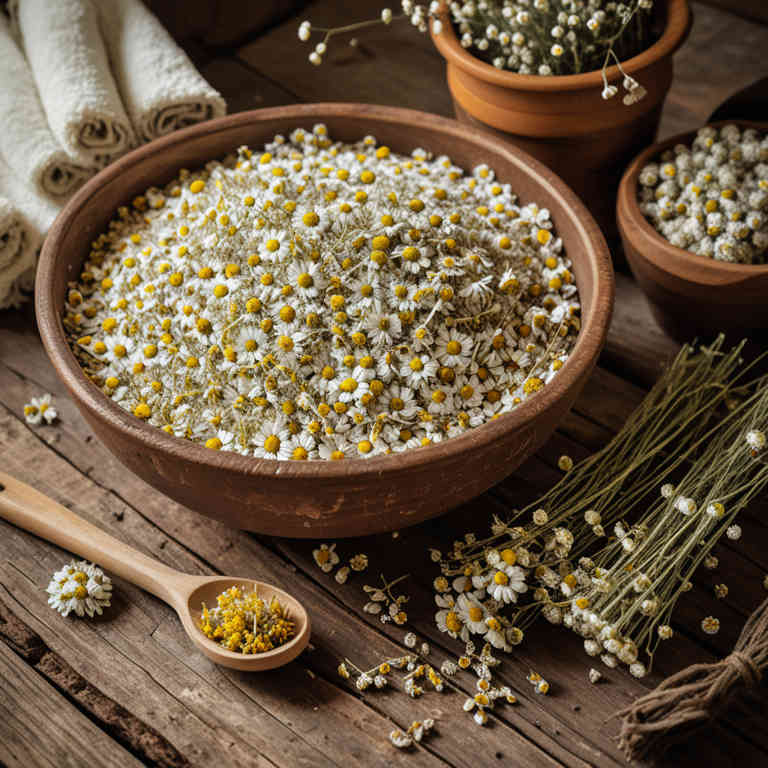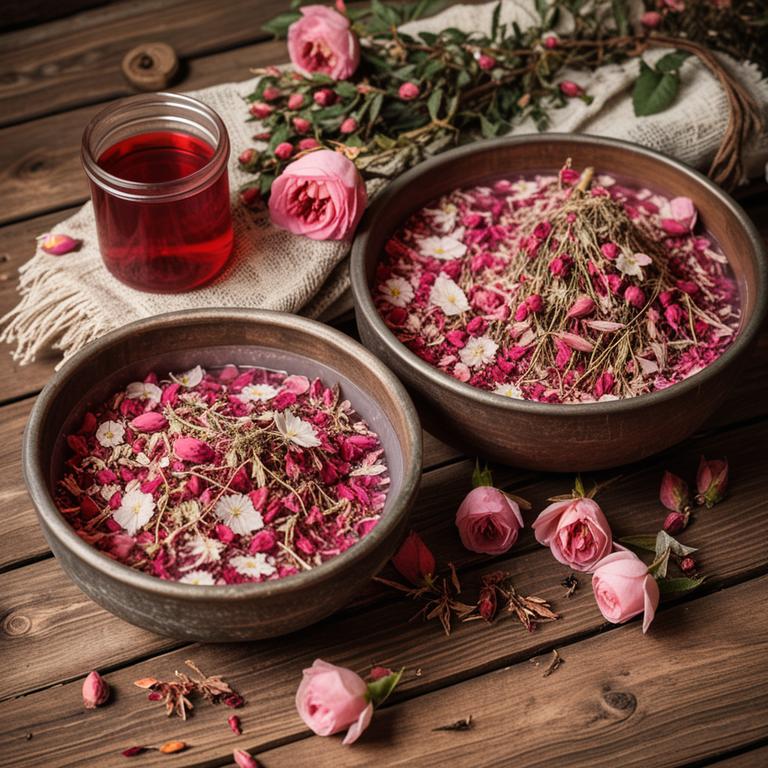10 Best Herbal Baths For Dry Eyes

Herbal baths for dry eyes involve soaking the eyes in a warm solution infused with natural herbs known for their soothing and hydrating properties.
Common herbs used include chamomile, lavender, and eyebright, which are believed to reduce inflammation and promote eye comfort. These baths can be prepared by steeping the herbs in hot water and allowing the solution to cool slightly before applying it to the closed eyelids. This practice is often recommended as a complementary therapy to conventional treatments for dry eye syndrome.
While herbal baths may offer relief for some individuals, it is important to consult with a healthcare professional before trying new treatments, especially if symptoms persist or worsen.
FREE Herb Drying Checklist
How to make sure every batch retains maximum flavor, color, and aroma without the risk of mold or over-drying. Eliminate guesswork and trial-and-error, making herb drying faster, easier, and more efficient every time.
Table of Contents
1. Equisetum arvense

Equisetum arvense, commonly known as field horsetail, has been traditionally used in herbal baths for its high concentration of silica, which is believed to support eye health.
When used in a warm bath, the silica from equisetum arvense may help to soothe dry eyes by improving tear production and reducing irritation. The anti-inflammatory properties of this plant may also contribute to alleviating redness and discomfort associated with dryness. To prepare the bath, a handful of dried equisetum arvense is boiled and then added to warm water, allowing the steam to gently penetrate the eyes.
While some people find relief from this natural remedy, it is advisable to consult with a healthcare professional before using it, especially for those with existing eye conditions.
2. Hypericum perforatum

Hypericum perforatum, commonly known as St. John's wort, has been traditionally used in herbal baths for its potential soothing and anti-inflammatory properties.
When infused into bath water, it may help alleviate symptoms of dry eyes by promoting relaxation and reducing irritation. The active compounds in hypericum, such as hyperforin and hypericin, are believed to have antioxidant and neuroprotective effects that may support eye health. However, it is important to consult with a healthcare provider before using hypericum baths, especially for individuals taking medications, as it can interact with certain drugs.
While some people find relief from dry eyes through herbal baths, more research is needed to fully understand its efficacy and safety in this context.
3. Salvia officinalis

Salvia officinalis, commonly known as sage, has been traditionally used for its soothing and anti-inflammatory properties, making it a promising ingredient for herbal baths aimed at alleviating dry eyes.
When infused into bath water, sage can help reduce eye irritation and redness by promoting a calming effect on the delicate eye area. The natural compounds in sage, such as rosmarinic acid and flavonoids, may support tear production and enhance the protective barrier of the eyes. To use sage in a bath, simply steep fresh or dried sage leaves in hot water for several minutes before adding it to a warm bath, allowing the steam to gently soothe the eyes.
While herbal baths can complement conventional treatments, it is advisable to consult a healthcare professional before incorporating new remedies into your eye care routine.
4. Urtica dioica

Urtica dioica, commonly known as stinging nettle, has been traditionally used in herbal baths to promote eye health and alleviate symptoms of dry eyes.
The leaves of this plant contain compounds such as vitamins A and C, antioxidants, and anti-inflammatory agents that may help reduce eye irritation and improve moisture retention. When used in a warm herbal bath, the steam from the infusion can soothe the eyes and potentially enhance tear production. Some proponents suggest that the minerals and nutrients in stinging nettle can support overall ocular wellness when absorbed through the skin.
However, it is important to consult with a healthcare professional before using stinging nettle baths, especially for individuals with sensitive skin or existing eye conditions.
5. Matricaria chamomilla

Matricaria chamomilla, commonly known as chamomile, is often used in herbal baths to provide relief for individuals suffering from dry eyes.
The soothing properties of chamomile are believed to help reduce eye irritation and redness by promoting a calming effect on the body and mind. When used in a warm bath, the essential oils from chamomile can be absorbed through the skin, potentially improving overall eye comfort. However, it is important to note that while some people find relief from chamomile baths, scientific evidence supporting its effectiveness for dry eyes is limited.
As with any alternative remedy, it is advisable to consult with a healthcare professional before incorporating chamomile baths into a treatment routine for dry eyes.
6. Achillea millefolium

Achillea millefolium, commonly known as yarrow, has been traditionally used in herbal remedies for its anti-inflammatory and soothing properties.
When incorporated into herbal baths, it may help alleviate symptoms of dry eyes by promoting circulation and reducing irritation around the eyes. To prepare an herbal bath, steep dried yarrow flowers in hot water for several minutes, then allow the liquid to cool before using it as a compress or adding it to a warm water bath. Some individuals find that the gentle warmth and calming effects of the bath can provide relief from dryness and discomfort.
However, it is important to consult with a healthcare professional before using any herbal remedy, especially if you have pre-existing eye conditions or allergies.
7. Chamomilla recutita

Chamomilla recutita, commonly known as German chamomile, is often used in herbal baths to alleviate symptoms of dry eyes due to its anti-inflammatory and soothing properties.
When infused into warm water, chamomile can help reduce irritation and redness by calming the delicate eye area. The essential oils in chamomile possess mild antiseptic qualities that may help prevent infections associated with dryness. A chamomile bath can also promote relaxation, which indirectly supports eye health by reducing stress-related strain.
However, it is important to consult a healthcare professional before using herbal remedies, especially if you have existing eye conditions or allergies.
8. Lavandula angustifolia

Lavandula angustifolia, commonly known as English lavender, has been traditionally used for its calming and soothing properties, making it a popular choice for herbal baths aimed at alleviating dry eyes.
When infused into bath water, lavender essential oil or dried lavender flowers can help reduce eye strain and promote relaxation, which may indirectly support eye health. The anti-inflammatory and antioxidant properties of lavender may help soothe irritated tissues around the eyes and improve overall comfort. Adding a few drops of lavender essential oil to warm bath water can create a relaxing sensory experience that complements eye care routines.
While herbal baths may provide symptomatic relief, they should not replace professional medical advice for persistent or severe dry eye conditions.
9. Rosmarinus officinalis

Rosmarinus officinalis, commonly known as rosemary, has been traditionally used in herbal baths for its soothing and anti-inflammatory properties, which can be beneficial for individuals suffering from dry eyes.
When infused into warm bath water, rosemary essential oil or dried leaves can help reduce eye strain and promote relaxation, potentially alleviating some symptoms associated with dryness and irritation. The aromatic compounds in rosemary may also stimulate circulation and improve tear production, offering natural relief for those with chronic dry eye syndrome. However, it is important to ensure that the bath is not too hot and that individuals with sensitive skin or allergies consult a healthcare provider before use.
Incorporating rosemary into a regular self-care routine can complement other treatments and enhance overall eye health and comfort.
10. Rosa canina

Rosa canina, also known as rosehip, is a traditional herbal remedy that has been used for centuries to support eye health and alleviate symptoms of dry eyes.
The oil extracted from Rosa canina fruits is rich in essential fatty acids, antioxidants, and vitamins, which can help nourish and hydrate the delicate eye tissues. When used in herbal baths, Rosa canina oil can be gently applied around the eyes to reduce inflammation and improve moisture retention. These baths are a safe and natural alternative to conventional treatments, offering a soothing effect without the risk of harsh side effects.
Incorporating Rosa canina into a daily eye care routine may provide long-term relief and promote overall ocular wellness.